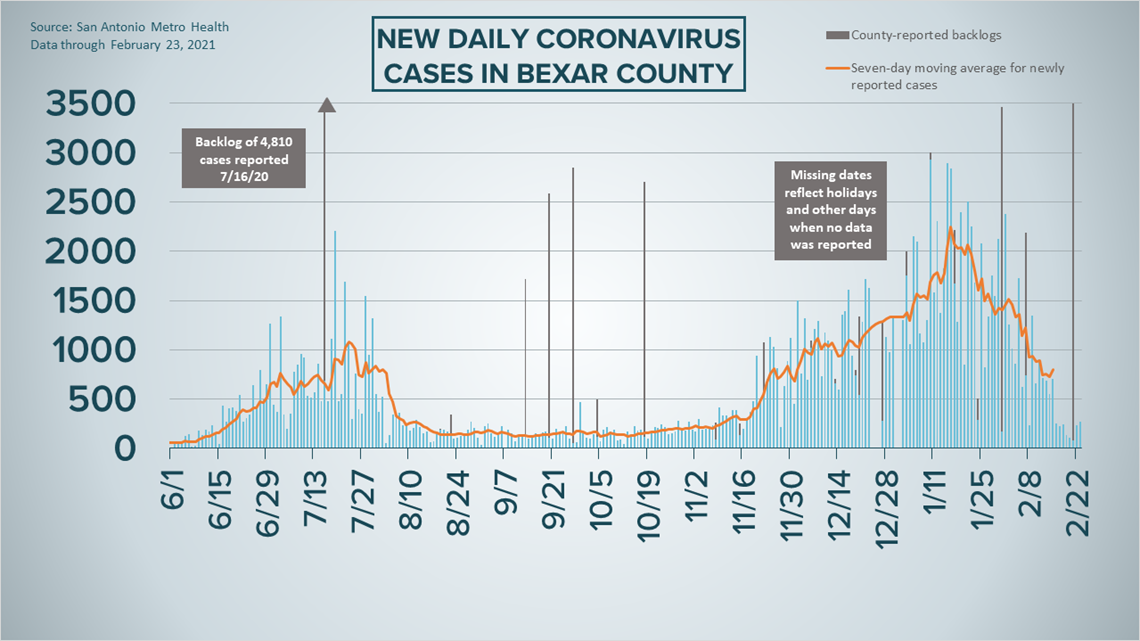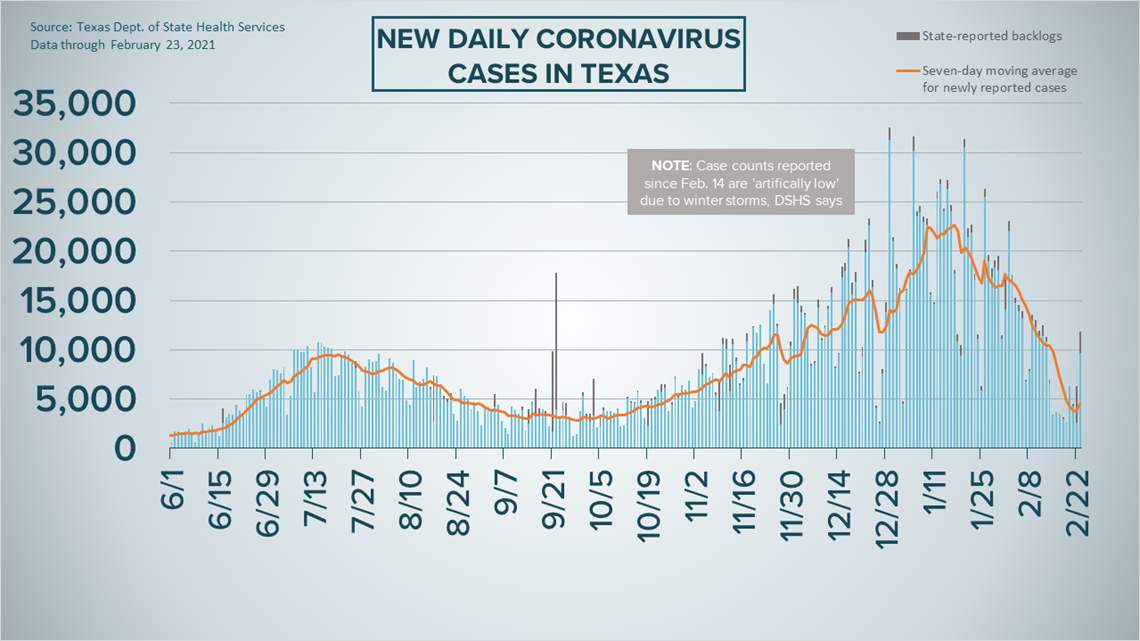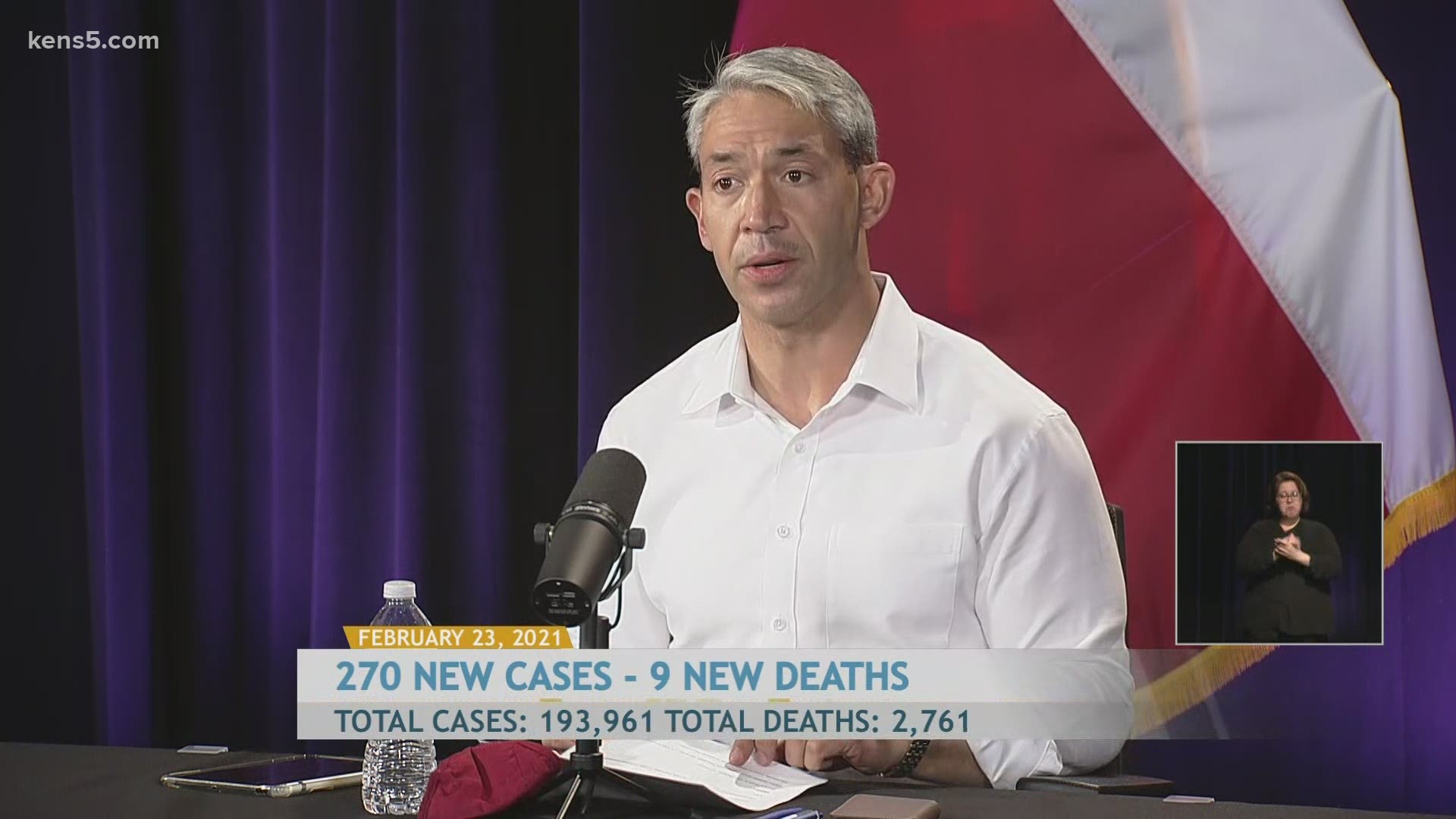SAN ANTONIO — We're tracking the latest numbers from the coronavirus pandemic in San Antonio and across Texas. Here are the latest numbers reported by Bexar and surrounding counties:
- Bexar County: On Tuesday, 270 new cases were reported, bringing the total number of cases to 193,961. Nine new deaths were also reported, raising the local death toll to 2,501.
- Hays County: On Tuesday, officials reported 84 new cases in the county and one additional COVID-related fatality. There is now a total of 16,120 lab-confirmed local cases, while the death toll rose to 209. Officials estimate 15,320 residents have recovered, while 519 are still ill with the virus on this date.
- Comal County: Officials on Tuesday reported 49 new cases and six additional COVID-related fatalities. As of Tuesday, 8,911 total COVID-19 cases have been reported, including 4,687 confirmed and 4,205 probable cases, while 284 county residents have died due to COVID-19 complications.
More county case information is available through the Texas Department of Health Services COVID-19 dashboard.
How Bexar County is trending
We've tracked how many coronavirus cases have been confirmed in Bexar County from the time officials began reporting cases in March 2020. The graphic below shows the number of cases since June and charts those daily case numbers along a 7-day moving average to provide a more accurate picture of the overall coronavirus case curve in our area and the direction we're trending amid the pandemic.
On Tuesday, Mayor Ron Nirenberg reported 270 additional coronavirus cases in Bexar County, bringing the local total to 193,961 since the pandemic began.
Nirenberg attributed the relatively low case total to minimal testing last week due to the winter storms. The seven-day rolling case average is at 639 as of Tuesday.
The mayor also reported nine new coronavirus-related deaths, for a total of 2,501 Bexar County fatalities. As a reminder, local health authorities categorize deaths from the last 14 days as "new."


After seeing a modest uptick Monday, local COVID-19 hospitalizations dropped by 39 on Tuesday—to a total of 569 COVID-19 patients receiving treatment for their symptoms. Of those 569 hospitalizations, 208 patients are in intensive care (down 15 from Monday) and 126 are on ventilators (up 26 from Monday).


Coronavirus in Texas
The total number of novel coronavirus cases in the state since the pandemic began grew by 11,809 on Tuesday, according to the Texas Department of State Health Services. That total includes 7,556 new confirmed cases, 2,148 new probable cases, and a backlog of 2,105. More details can be found on this page.
Tuesday's figures bring the total number of Texans diagnosed with COVID-19 to more than 2.606 million.


Meanwhile, state health authorities reported an additional 234 deaths from coronavirus complications in Texas. In all, 41,641 Texans have died from COVID-19.
Hospitalizations saw a rare 2021 increase on Tuesday, albeit a small increase. The number of COVID-19 patients receiving treatment for their symptoms throughout Texas increased by 50, to a current count of 7,014 on Tuesday. Despite the slight uptick, the state remains on a major downward trend when it comes to hospitalizations—a prolonged decrease that began in mid-January, when Texas topped out at more than 14,200 hospitalized COVID-19 patients.
The state, meanwhile, estimates that about 2.353 million Texans have recovered, while 192,883 Texans remain ill with COVID-19.
The latest update from the Texas Education Agency showed that there have been at least 175,077 cumulative cases among staff and students on Texas public school campuses through Feb. 7. That number comprises 113,311 positive student cases and 61,766 staff cases. More information can be found here.
The TEA typically releases new data on school cases on Fridays, but last week's data is delayed due to the past week's storms.
Latest Coronavirus Headlines
- U.K. studies show COVID-19 vaccines led to sharp drop in hospital admissions
- Who's Hiring: Companies still looking for employees during coronavirus pandemic
- Spurs update injury report, hold practice for first time since positive coronavirus tests postponed games
- President Biden pays tribute to over 500,000 lives lost to COVID-19
- HHS nominee Becerra says pandemic is top job, but agenda is broader
- Biden administration to send millions of masks to Americans 'very shortly'
- Life after COVID-19: Some grocery store changes may stick around
- Another COVID-19 vaccine shipment delayed; Alamodome appointments rescheduled
Coronavirus symptoms
The symptoms of coronavirus can be similar to the flu or a bad cold. Symptoms include fever or chills, cough, shortness of breath or difficulty breathing, fatigue, muscle or body aches, headache, new loss of taste or smell sore throat, congestion or runny nose, nausea or vomiting, and diarrhea, according to the Centers for Disease Control.
Most healthy people will have mild symptoms. A study of more than 72,000 patients by the Centers for Disease Control in China showed 80 percent of the cases there were mild.
But infections can cause pneumonia, severe acute respiratory syndrome, kidney failure, and even death, according to the World Health Organization. Older people with underlying health conditions are most at risk.
Experts determined there was consistent evidence these conditions increase a person's risk, regardless of age:
- Chronic kidney disease
- COPD (chronic obstructive pulmonary disease)
- Obesity (BMI of 30 or higher)
- Immunocompromised state (weakened immune system) from solid organ transplant
- Serious heart conditions, such as heart failure, coronary artery disease, or cardiomyopathies
- Sickle cell disease
- Type 2 diabetes
The CDC believes symptoms may appear anywhere from two to 14 days after being exposed.
Human coronaviruses are usually spread...
- Between people who are in close contact with one another (within about 6 feet).
- Through respiratory droplets produced when an infected person coughs, sneezes or talks. These droplets can land in the mouths or noses of people who are nearby or possibly be inhaled into the lungs.
- Some recent studies have suggested that COVID-19 may be spread by people who are not showing symptoms.
Help stop the spread of coronavirus
- Stay home when you are sick.
- Eat and sleep separately from your family members
- Use different utensils and dishes
- Cover your cough or sneeze with your arm, not your hand.
- If you use a tissue, throw it in the trash.
Find a Testing Location
City officials recommend getting a COVID-19 test if you experience fever or chills, cough, shortness of breath or difficulty breathing, fatigue, muscle or body aches, headache, new loss of taste or smell, sore throat, congestion or runny nose, nausea or vomiting, or diarrhea.
A self-screening tool is available to see if you need a test.
San Antonio operates several no-cost testing locations, including two walk-up locations open Monday-Sunday from 10 a.m. until 2 p.m.:
Cuellar Community Center
5626 San Fernando St.
San Antonio, TX 78237Ramirez Community Center
1011 Gillette Blvd.
San Antonio, TX 78224Additionally, Freeman Coliseum offers drive-through no-cost testing from Monday through Sunday between 9 a.m. and 4 p.m. An appointment is required and can be made either online or by calling (833) 213-0643.
Here's a Testing Sites Locator to help you find the testing location closest to you in San Antonio.

